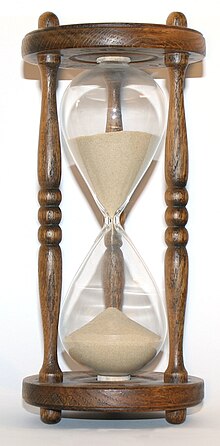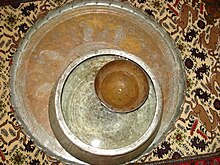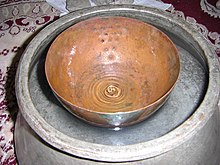計時工具的歷史
此條目翻譯品質不佳。 |

千百年來,人類利用各種裝置來計時和報時。目前正在使用的六十進制時間系統,大約可以追溯至公元前2000年的蘇美爾。古埃及把一天分為二個部份,每一部份再分為12個小時,並使用大型方尖碑追蹤太陽的移動。他們還發明了水鐘(water clocks)。Precinct of Amun-Re 很可能是最初使用水鐘的地方,後來在埃及以外的地方也有人使用水鐘;古希臘人就經常使用叫作clepsydrae的水鐘。約在同一時間,相信商朝已使用洩水型水鐘──漏壺;而漏壺可能早在公元前2000年,從美索不达米亚傳入。其他古代計時器包括有蠟燭鐘──在中国、日本、英格蘭,和伊拉克使用;日晷──在印度和西藏,以及歐洲一些地區廣泛使用;此外,還有沙漏,運作原理和水鐘一樣。
最早期的計時工具日晷依靠太陽的陰影來報時,所以它們在多雲的天氣或夜間,沒有用處;而且如果“晷針”跟地球的軸心不一致,這些計時工具要依季節的變化,而重新校準。
第一個使用擒縱器(escapement)的鐘,於八世紀在中國出現[1]。11世紀,穆斯林工程師發明以重量驅動(weight-driven)的鐘。14世紀初,歐洲發明機械鐘。直到20世紀,機械鐘都是標準計時裝置。在20世紀,發明了石英振盪器,然後是原子鐘。石英振盪器最初只在實驗室使用,可是由於它容易生產而且準確,所以後來用在手錶上。原子鐘比所有計時裝置都準確,所以可以用於校準其他鐘錶;並且用來計算原子时和协调世界时。
早期的計時工具
[编辑]許多古老的文明會觀察天體──通常是太陽和月亮,以確定時間、日期和季節[2][3]。現今在西方社會通用的六十進制時間系統,可追溯至約四千年前的美索不達米亞和古埃及 [2][4][5];後來,中美洲地區開發類似的系統[6]。
第一個日曆,可能在冰河時代末期,由狩獵收集者創造。他們利用如樹枝和骨頭等工具,記錄月相和季節[3]。 世界各地──特別是在史前時期的歐洲──都有石陣,例如英格蘭的巨石陣。石陣相信是用來預測晝夜平分點(equinoxes)或至點(亦稱二至點;solstices)等的時間[7][3]。那些巨石文明(Megalith)沒有留下歷史紀錄;因此,現代對他們的日曆或計時方法,所知甚少[8]。


公元前3500年至公元前500年
[编辑]日影鐘是第一個能夠量度小時的裝置[9]。已知道最古老的日影鐘來自埃及,用綠片岩製造。古埃及約在公元前3500年建造的方尖碑,也是最早的日影鐘之一[10][3]。
埃及的日影鐘把白天分為十個部分,另外加上4個“微亮小時”── 早上 2個、傍晚 2個。有一種日影鐘由一枝長桿和高架橫桿組成,長竿上有5個不相等的記號,橫桿的陰影會投射到記號之上。橫桿在早上指向東方,在正午會指向西方。方尖碑的運作方式差不多:陰影投射到圍繞它的記號上,埃及人從而可以計算時間。方尖碑可以指出上午或下午、夏至或冬至[3][11]。
現在己知最古老的水鐘 ,在法老阿蒙霍特普一世(公元前1525年至1504年)的墓中發現,這顯示古埃及最先使用水鐘[11][12][13]。另一方面,相信沙漏也是由古埃及人發明。此外,埃及自公元前600年,開始使用叫作merkhet的鉛垂線在晚間量度時間。這工具的鉛垂線跟勾陳一(北極星)一致,形成南北子午圈。當特定的星宿橫過線時,就能準確報時[11][14]。
公元前500年至公元前1年
[编辑]柏拉圖把水鐘(漏壺)引進古希臘之後,水鐘成為古希臘廣泛使用的計時工具。柏拉圖也發明了一種以水鐘為基礎的鬧鐘[15][16]。希臘人和新巴比倫王國保存計時記錄,作為組成天體觀察的重要部分。漏壺也用在希臘法庭,和後來的羅馬法庭上。
雖然水鐘比日影鐘更好用──水鐘在室內、夜間或天空多雲的日子都可以使用;不過它們並不準確。因此,希臘人尋求方法改善他們的水鐘[17]。到了公元前325年,水鐘的準確度大為改善,雖然仍然及不上日影鐘。這時的鐘有鐘面,其上有時針,令人更容易讀準時間。水鐘較常見的問題是水壓:當容器注滿水時,增加的水壓令水流更迅速。在公元前100年,希臘和羅馬的鐘錶專家,開始解決這個問題;其後的幾個世紀,在這一方面得到持續改善。為了抵消高水壓增加的水流量做成的影響,裝水的容器造成圓錐形狀,上濶下窄。於是雖然水平面下降的距離相等,但當容器水滿的時候,流出的水要比水半滿的時候多。然而,還是有些問題沒有得到解決:如溫度的影響。天氣寒冷的時候,水流比較緩慢,甚至可能凍結[18]。
雖然希臘人和羅馬人大大改進水鐘的技術,他們仍然繼續使用影子鐘錶。據說數學家和天文學家比提尼亞的狄奧多,發明了全球通用的日晷。這個日晷在地球上任何地方都能準確報時,不過現代對它所知甚少[19]。羅馬人在奧古斯都大帝統治期間,建造有史以來最大的日晷──奧古斯都日晷(Solarium Augusti)。其晷針是從赫利奧波利斯(Heliopolis)而來的方尖碑[20]。
公元1-1500年
[编辑]水鐘
[编辑]李約瑟推測水鐘──漏壺可能從兩河流域傳入中國,時間可能早達公元前二世紀的商代,最遲不會晚於公元前一世紀。由漢代(公元前202)開始,泄水型漏壺逐步被受水型漏壺取代,其特色是浮在受水壺水面上的漏箭,隨水面上升指示時間。
蠟燭鐘
[编辑]蠟燭鐘在何處及何時首次使用己不可考。不過,最早提到蠟燭鐘的,是一首寫於520年的中國詩。詩中說,燃燒的蠟燭是夜間量度時間的方法。直到10世紀初,日本一直使用類似的蠟燭鐘[21]。
香鐘
[编辑]遠東地區除了使用水鐘、機械鐘和蠟燭鐘外,也會使用香鐘計時[22]。中國大約在六世紀首先使用香鐘。在日本的正仓院,仍保存了一個香鐘[23],不過在其上的文字不是漢文,而是梵文[24]。由於佛教經常使用梵文,因此愛德華.沙菲爾推測香鐘在佛教儀式中使用,而且是由印度人發明[24]。香鐘跟蠟燭鐘很相似,不過香燒均勻而且無火焰,因此在室內使用時,比蠟燭鐘更準確和更安全[25]。
使用擒縱器的水鐘
[编辑]第一使用擒纵器的水鐘,由密宗僧人兼數學家一行和政府官梁令瓚建於長安[26][27] 這個擒縱器水鐘是個天文數儀器。一行的擒縱器鐘仍然是一個水鐘,因此會受溫度變化的影響。在976年,張思訓解決了這個問題。他用汞(水銀)取代水,汞在溫度下降到攝氏零下39度(華氏零下38度)時,仍然是液體。
天文鐘
[编辑]元祐元年(1086年)蘇頌檢驗太史局的渾儀時,決心要將渾儀、浑象和報時裝置結合。蘇頌拜訪吏部守當官韓公廉,取得張衡、張思訓的“儀器法式大綱”。元祐三年(1088年)開始動工,元祐七年(1092年)「水運儀象台」竣工。
水運儀象台是一個類似於天文臺,高約12米,寬7米,上下分三層;上層是渾天儀(天體測量之用),中層是渾象儀(天體運行演示),下層是司辰(自動報時器),全程用水力推動,可精確報時,李約瑟指這是歐洲天文钟的直接祖先。蘇頌於紹聖初年著《新儀像法要》一書,詳述水運儀象台的整體功能、零件150多種,60多幅插圖。
水運儀象台原件在靖康之禍(1127年)時,金兵將水運儀象台掠往燕京(北京)置於司天台,在金朝貞祐二年(1214年)因不便運輸被丟棄,而南宋時蘇携保存的手稿因無人理解其中方法而無人能仿造。
近代計時工具
[编辑]機械鐘
[编辑]

機械鐘由僧人一行和官員梁令瓚發明。至元明之時,計時器擺脫了天文儀器的結構形式,得到了突破性的新發展。元初郭守敬、明初詹希元創製了「大明燈漏」與「五輪沙漏」,採用機械結構,並增添盤、針來指示時間,其機械的先進性便明顯地顯示出來,時間性益見準確。
到14世紀,西方國家廣泛使用機械鐘。在十六世紀,奧斯曼帝國的科學家達茲·艾-丁(Taqi al-Din)發明機械鬧鐘[28]。
擺鐘
[编辑]1583年,意大利人伽利略建立了著名的等時性理論,也就是鐘擺的理論基礎。1656年,荷蘭的科學家克里斯蒂安·惠更斯應用伽利略的理論,設計了鐘擺。第二年,在他的指導下,年輕鐘匠哥士達(S. Coster)成功製造第一個擺鐘。1675年,他又用遊絲取代了原始的鐘擺,這樣就形成了以發條為動力、以遊絲為調速機構,但擺鐘外形較大,不方便攜帶
袋錶
[编辑]18世紀期間發明了各種各樣的擒縱結構,為袋錶(或稱懷錶)的發展奠定了基礎。英國人喬治·葛咸(George Graham)在1726年完善工字輪擒縱結構;它和之前發明的垂直放置的機軸擒縱結構不同,所以使得袋錶機芯相對變薄。另外,1757年左右,英國人湯馬士·穆治(Thomas Mudge)發明了叉式擒縱結構,進一步提高了袋錶計時的精確度。這期間一直到19世紀,產生了大批鐘錶生產廠家,為袋錶的發展做出了貢獻。
手錶
[编辑]1904年,飛行員阿爾拔圖·桑托斯-杜蒙特要求他的朋友,法國製錶匠路易士·卡地亞(Louis Cartier),設計一個他可以在飛行時使用的錶[29]。其實在1868年,百达翡丽已經發明了手表,不過當時這種女士的手鐲錶,只當作首飾。卡地亞創造了桑托斯(Santos)手錶,第一隻為男士設計而且實用的手錶[30]。
石英振盪器
[编辑]1921年,華持·加廸(Walter G. Cady)製造第一個石英晶体谐振器。沃倫·馬利遜(Warren Marrison J. W. Horton)和JW.霍頓(J. W. Horton)於1927年,在加拿大的贝尔实验室製造首個石英钟[31][32]。之後幾十年,因為由真空管組成的石英鐘笨重,它只能設置於實驗室中。
1967年瑞士人發表第一款石英錶,1969年,精工製作了世界上第一個商業化生產的石英手錶──雅士圖(Astron)[33]。它的準確性和低生產成本,石英鐘錶受歡迎。
原子鐘
[编辑]原子鐘比所有計時裝置都準確,數萬年才會誤差幾秒鐘,所以可以用於校準其他鐘錶[34]。第一個原子鐘於1949年發明,現陳列於史密森尼学会。美國國家標準局(又稱國家標準技術研究所)的銫原子鐘,每年的誤差只有300億分之一秒。
註釋
[编辑]- ^ David Landes: “Revolution in Time: Clocks and the Making of the Modern World”, rev. and enlarged edition, Harvard University Press, Cambridge 2000, ISBN 0674002822, p.18f.
- ^ 2.0 2.1 Chobotov, p. 1
- ^ 3.0 3.1 3.2 3.3 3.4 Bruton, Eric. The History of Clocks and Watches 1982. New York: Crescent Books. 1979. ISBN 0-517-377446.
- ^ Barnett, p. 102
- ^ Knight & Butler, p. 77
- ^ Aveni, p. 136
- ^ Ancient Calendars. National Institute of Standards and Technology. [2008-04-30]. (原始内容存档于2008-04-09).
- ^ Richards, p. 55
- ^ Major, p. 9
- ^ Sundial. Encyclopedia Britannica. [2008-04-04]. (原始内容存档于2015-05-05).
- ^ 11.0 11.1 11.2 Earliest Clocks. A Walk Through Time. NIST Physics Laboratory. [2008-04-02]. (原始内容存档于2008-03-15).
- ^ Philbin, p. 128
- ^ Cotterell, pp. 59–61
- ^ Whitrow, p.28
- ^ O'Connor, J. J.; Robertson, E. F. Plato biography. School of Mathematics and Statistics, University of St. Andrews. [2007-11-29]. (原始内容存档于2018-10-01).
- ^ Hellemans, Alexander; Bunch, Bryan H. The History of Science and Technology: A Browser's Guide to the Great Discoveries, Inventions, and the People Who Made Them, From the Dawn of Time to Today. Boston: Houghton Mifflin. 2004: p. 65. ISBN 0-618-22123-9.
- ^ Aveni, Anthony F. Empires of Time: Calendars, Clocks, and Cultures. Tauris Parke Paperbacks. 2000: p. 92 [2008-06-22]. ISBN 1860646026. (原始内容存档于2015-03-19).
- ^ Collier, James Lincoln. Clocks. Tarrytown, NY: Benchmark Books. 2003: p. 25. ISBN 0-7614-1538-6.
- ^ O'Connor, J. J.; Robertson, E. F. Theodosius biography. School of Mathematics and Statistics, University of St. Andrews. [2008-04-01]. (原始内容存档于2017-03-22).
- ^ Buchner, Edmund. Solarium Augusti und Ara Pacis. Römische Mitteilungen. 1976, 83 (2): pp. 319–375 (德语).}
- ^ Flamer, Keith. History of Time. International Watch Magazine. 2006 [2008-04-08]. (原始内容存档于2011-07-16).
- ^ Richards, p. 52
- ^ Pagani, Catherine. Eastern Magnificence and European Ingenuity: Clocks of Late Imperial China. University of Michigan Press. 2001: p. 209 [2008-06-21]. ISBN 0472112082. (原始内容存档于2020-09-27).
- ^ 24.0 24.1 Schafer, Edward. The Golden Peaches of Samarkand: A Study of T'ang Exotics. University of California Press. 1963: pp. 160–161 [2008-09-17]. ISBN 0520054628. (原始内容存档于2015-03-19).
- ^ Chang, Edward; Lu, Yung-Hsiang. Visualizing Video Streams using Sand Glass Metaphor. Stanford University. December 1996 [2008-06-20]. (原始内容存档于2017-10-10).
- ^ American Society of Mechanical Engineers. Proceedings of the 2002 ASME Design Engineering Technical Conferences. American Society of Mechanical Engineers. 2002. ISBN 079183624X.
- ^ Schafer, Edward H. Great Ages of Man: Ancient China. New York: Time-Life Books. 1967: p. 128.
- ^ Al-Hassani, Salim. The Astronomical Clock of Taqi Al-Din: Virtual Reconstruction. FSTC. 19 June 2008 [2008-07-02]. (原始内容存档于2008-07-12).
- ^ Silva de Mattos, Bento. Alberto Santos-Dumont. American Institute of Aeronautics and Astronautics. [2008-06-21]. (原始内容存档于2004-09-13).
- ^ Prochnow, Dave. Lego Mindstorms NXT Hacker's Guide. McGraw-Hill. 2006. ISBN 0071481478.
- ^ Marrison, W. A.; Horton, J. W. Precision determination of frequency. I.R.E. Proc. February 1928, 16: pp. 137–154.
- ^ Marrison, vol. 27 pp. 510–588
- ^ Electronic Quartz Wristwatch, 1969. IEEE History Center. [2007-08-31]. (原始内容存档于2009-02-26).
- ^ Dick, Stephen. Sky and Ocean Joined: The U.S. Naval Observatory, 1830–2000. Cambridge University Press. 2002: p. 484 [2008-06-20]. ISBN 0521815991. (原始内容存档于2020-02-18).
參考
[编辑]- Alder, Ken. The Measure of All Things: The Seven-Year Odyssey and Hidden Error that Transformed the World. London: Little, Brown. 2002. ISBN 0743216768. OCLC 53324804.
- Aveni, Anthony. Skywatchers: A Revised and Updated Version of Skywatchers of Ancient Mexico. Austin, TX: University of Texas Press. 2001 [2008-06-20]. ISBN 0292705026. OCLC 45195586. (原始内容存档于2015-03-19).
- Barnett, Jo Ellen. Time's Pendulum: From Sundials to Atomic Clocks, the Fascinating History of Timekeeping and How Our Discoveries Changed the World 1st. San Diego, CA: Harcourt Trade Publishers. 1998 [2008-06-20]. ISBN 0156006499. OCLC 40255897. (原始内容存档于2017-09-19).
- Berlev, Oleg. Bureaucrats. Donadoni, Sergio (编). The Egyptians. Trans. Bianchi, Robert et al. Chicago, IL: The University of Chicago Press. 1997. OCLC 35808323. ISBN 0226155552.
- Bottomley, Frank. The Castle Explorer's Guide. New York, NY: Crown Publishers. 1983. ISBN 0517421720. OCLC 9762252.
- Clarke, Howard B.; Dent, Sarah; Johnson, Ruth. Dublinia: The Story of Medieval Dublin. Dublin, Ireland: O'Brien. 2002. ISBN 0862787858. OCLC 50528116.
- Chobotov, Vladimir. Orbital Mechanics 3rd. Reston, VA: AIAA. 2002 [2008-06-20]. ISBN 1563475375. OCLC 49923275. (原始内容存档于2015-03-19).
- Cotterell, Brian; Kamminga, Johan. Mechanics of Pre-Industrial Technology: An Introduction to the Mechanics of Ancient and Traditional Material Culture. Cambridge: Cambridge University Press. 1990. ISBN 0521428718. OCLC 18520966.
- Davies, Norman. Europe: A History. Oxford: Oxford University Press. 1996. ISBN 0198201710. OCLC 35593922.
- Frugoni, Chiara. Pietro et Ambrogio Lorenzetti. New York, NY: Scala Books. 1988. ISBN 0935748806. OCLC 18827370.
- Knight, Christopher; Butler, Alan. Civilization One: The World is Not as You Thought It Was. London. [2008-09-11]. ISBN 1842930958. OCLC 57313245. (原始内容存档于2015-03-19).
- Major, Fouad G. The Quantum Beat: The Physical Principles of Atomic Clocks. New York, NY: Springer. 1998 [2008-06-22]. ISBN 0387983015. OCLC 37315254. (原始内容存档于2015-03-19).
- Marrison, Warren A. The Evolution of the Quartz Crystal Clock. Bell System Technical Journal (AT&T). 1948, 27: 510–88 [2008-09-11]. OCLC 10999639. (原始内容存档于2007-05-13).
- Philbin, Tom. The 100 Greatest Inventions of All Time: A Ranking Past to Present. New York, NY: Citadel Press. 2005 [2008-06-20]. ISBN 0806524049. OCLC 57166331. (原始内容存档于2020-07-31).
- Reid, Thomas. Treatise on Clock and Watch Making: Theoretical and Practical. Carey and Lea. 1832 [2008-09-11]. OCLC 17454059. (原始内容存档于2014-06-06).
- Richards, E. G. Mapping Time: The Calendar and its History. Oxford: Oxford University Press. 1998. ISBN 0198504136. OCLC 185547970.
- Whitrow, Gerald J. Time in History: Views of Time from Prehistory to the Present Day 1st. Oxford: Oxford University Press. 1989 [2008-09-11]. ISBN 0192852116. OCLC 21182984. (原始内容存档于2017-02-17).
- Woods, Thomas, Thomas. How the Catholic Church Built Western Civilization. Washington D.C., United States. 2005. ISBN 0895260387. OCLC 58720707.
廷伸閱讀
[编辑]- Andrews, William J. H. The Quest for Longitude. Cambridge, Massachusetts: Harvard University Press. 1996. ISBN 978-0964432901. OCLC 59617314.
- Audoin, Claude; Guinot, Bernard. The Measurement of Time: Time, Frequency, and the Atomic Clock. Cambridge: Cambridge University Press. 2001: p. 346. ISBN 0521003970.
- Bartky, Ian R. The Adoption of Standard Time. Technology and Culture. January 1989, 30: pp. 25–56. doi:10.2307/3105430.
- Breasted, James H., "The Beginnings of Time Measurement and the Origins of Our Calendar", in Time and its Mysteries, a series of lectures presented by the James Arthur Foundation, New York University, New York: New York University Press, 1936, pp. 59–96.
- Cowan, Harrison J. Time and Its Measurements. Cleveland: World Publishing Company. 1958: p. 159.
- Dohrn-Van Rossum, Gerhard. History of the Hour: Clocks and Modern Temporal Orders. Chicago: University of Chicago Press. 1996: p. 463. ISBN 0226155102.
- Garver, Thomas H. Keeping Time. American Heritage of Invention & Technology. Fall 1992, 8 (2): pp. 8–17.
- Goudsmit, Samuel A.; Claiborne, Robert; Millikan, Robert A.; et al. Time. New York: Time Inc. 1996.
- Hawkins, Gerald S. Stonehenge Decoded. Garden City, N.Y.: Doubleday. 1965: p. 202. ISBN 978-0385041270.
- Hellwig, Helmut; Evenson, Kenneth M.; Wineland, David J. Time, Frequency and Physical Measurement. Physics Today. December 1978, 23: pp. 23–30.
- Hood, Peter. How Time Is Measured. London: Oxford University Press. 1955: p. 64. ISBN 0198366159.
- Howse, Derek. Greenwich Time and the Discovery of the Longitude. Philip Wilson Publishers, Ltd. 1980: p. 254.
- Humphrey, Henry; O'Meara-Humphrey, Deirdre. When is Now?: Experiments with Time and Timekeeping Devices. Doubleday Publishing. 1980: p. 79 [2008-09-11]. ISBN 0385132158. (原始内容存档于2015-01-28).
- Itano, Wayne M.; Ramsey, Norman F. Accurate Measurement of Time. Scientific American. July 1993, 269: pp. 56–65.
- Jespersen, James; Hanson, D. Wayne. Special Issue on Time and Frequency. Proceedings of the IEEE. July 1991, 74 (7).
- Jespersen, James; Fitz-Randolph, Jane. From Sundials to Atomic Clocks: Understanding Time and Frequency 2nd (revised) edition. Mineola, New York: Dover Publications. 2000: p. 345. ISBN 0486409139.
- Jones, Tony. Splitting the Second: The Story of Atomic Timekeeping. Bristol, UK: Institute of Physics Publishing. 2000: p. 199. ISBN 978-0750306409.
- Landes, Davis S. A Revolution in Time: Clocks and the Making of the Modern World. Cambridge, Massachusetts: Harvard University Press. 2000: p. 518. ISBN 978-0674768000.
- Lombardi, Michael A., NIST Time and Frequency Services, NIST Special Publication 432*, revised 2002.
- Mayr, Otto. The Origins of Feedback Control. Scientific American. October 1970, 223 (10): pp. 110–118.
- Merriam, John C., "Time and Change in History", Time and Its Mysteries, (see Breasted above), pp. 23–38.
- Millikan, Robert A., "Time", Time and Its Mysteries, (see Breasted above) pp. 3–22.
- Morris, Richard. Time's Arrows: Scientific Attitudes Toward Time. New York: Simon and Schuster. 1985: p. 240. ISBN 978-0671617660.
- Needham, Joseph; Ling, Wang; deSolla Price, Derek J. Heavenly Clockwork: The Great Astronomical Clocks of Medieval China. Cambridge: Cambridge University Press. 1986: p. 253. ISBN 978-0521322768.
- Parker, Richard Anthony. The Calendars of Ancient Egypt. University of Chicago. 1950. OCLC 2077978.
- Priestley, John Boynton. Man and Time. Garden City, New York: Doubleday. 1964: p. 319.
- Seidelmann, P. Kenneth, ed., Explanatory Supplement to the Astronomical Almanac, Sausalito, Calif.: University Science Books, 1992.
- Shallies, Michael. On Time: An Investigation into Scientific Knowledge and Human Experience. New York: Schocken Books. 1983: p. 208. ISBN 978-0805238532.
- Snyder, Wilbert F. and Charles A. Bragaw, "In the Domains of Time and Frequency" (Chapter 8), Achievement in Radio, NIST Special Publication 555*, 1986.
- Sobel, Dava. Longitude. London, England: HarperPerennial. 2005: p. 208. ISBN 978-0007214228. OCLC 60795122.
- Thompson, David, The History of Watches, New York: Abbeville Press, 2008.
- Waugh, Alexander. Time: Its Origin, Its Enigma, Its History. Carroll & Graf Publishing. 1998: p. 280. ISBN 0786707674.
